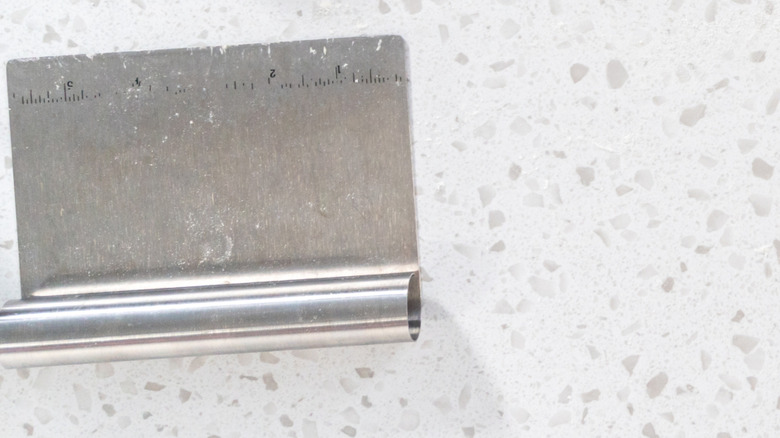How To Cut Your Butter Like A Pro
We may receive a commission on purchases made from links.
Baking can be a painstaking science, from the tedious sifting of flour (which Duff Goldman never skips), to the patience that is required to make bread. Whatever your recipe calls for, you'll do it, but sometimes with a grimace. Take cutting butter, for example. Most baking recipes call for unsalted butter (although salted has its uses too), and most pie or biscuit recipes call for that butter to be cubed. Normally, you'd just whip out a sharp knife to do the job, but there is an easier — and dare we say, more professional — method for cubing the golden stuff. All you need is a bench scraper.
If you've ever looked into a restaurant kitchen you've probably seen a cook using a bench scraper: A thin sheet of metal (typically), topped off on one end with a wooden or plastic handle. To use, just position the bottom of the "blade" lengthwise along the unwrapped stick of butter. Make one long slice through the middle of the stick then rotate the bench cutter in your hand so that it's perpendicular to the horizontal slice and cut through vertically to make cubes.
Why bench scrapers are great for cutting butter
Bench scrapers, like this Stainless Steel Bench Scraper from OXO, are actually roughly the same length as a stick of butter; if the knife you have is too short, you're going to have to cut it as much as you can lengthwise, then rotate the stick to finish the job on the other side. Why go through that hassle when a bench scraper can make the long cut in one motion?
While the bench scraper has a sharp enough edge to slice through cold butter, the "blade" also isn't so sharp that you have to worry about cutting yourself (plus, some models have non-slip handles; even if your hands are wet, the tool should stay firmly put). You can even use the scraper to cut butter directly into a mixing bowl without having to worry about accidentally taking the end of your thumb off.
There is also the fact that, thanks to the bench scraper's wider blade (they tend to be rectangular in shape), you can easily scoop up all the butter you've just cut and move it wherever you need to. Finally, the bench scrapers' original purpose was to remove any stuck on dough from the surface where it was worked. This means it is also good at removing any butter residue that might remain on a surface after it has been cut.


